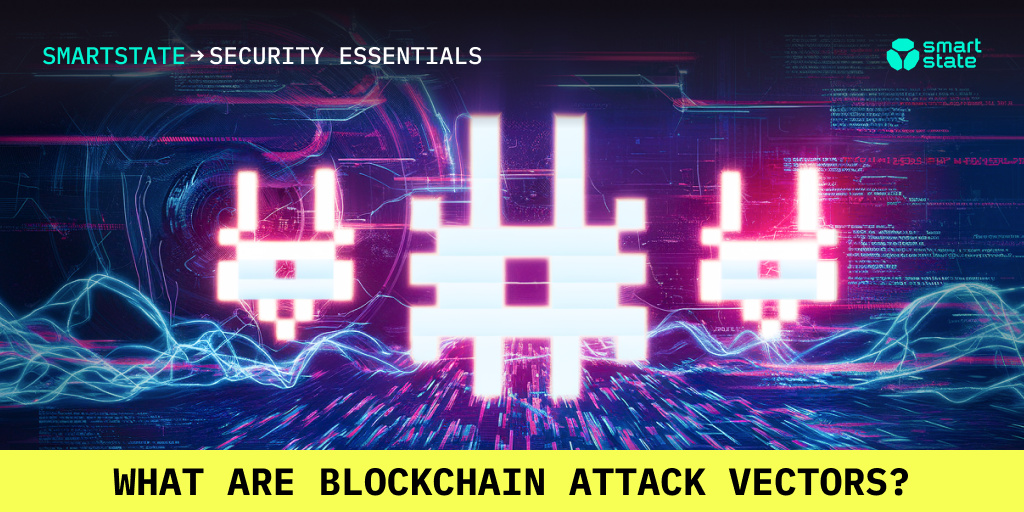What are Blockchain Attack Vectors?
The use of blockchain technology is on the rise, bringing with it an increase in security risks. Cybercriminals are constantly seeking new ways of blockchain systems exploitation, compromising security and stealing digital assets. In this article, we explore the attack vector topic, the most common blockchain attack vectors examples and several protection measures to better understand the subject, the risks and take proactive actions to protect funds and assets.
Attack vector: what is it?
Attack vector is the method or means by which an attacker gains access to a system with the intention of exploiting vulnerabilities, stealing data, or causing other harm types. There are various attack vectors types, for example attack vectors in Web2 can be:
- Network attacks (hacking, phishing, man-in-the-middle attacks)
- Social engineering attacks (pretexting, baiting, quid pro quo)
- Physical attacks (theft of physical devices, tampering with equipment)
- Application-layer attacks (SQL injection, cross-site scripting)
- Web-based attacks (clickjacking, drive-by downloads)
Attack vectors can be used to exploit weaknesses in software, hardware, or human behavior. Attackers may combine techniques to gain access and achieve their goals.
So, in summary, attack vector features are:
- It refers to a specific method or means by which an attacker gains access or exploits a system, network, or app.
- It is a single path or technique used to breach security (e.g., phishing, SQL injection, or exploiting a vulnerability).
- It typically targets a specific weakness or vulnerability in the system.
Top-7 common blockchain-related attack vectors
1. Smart Contract Exploitation
Smart contracts are the foundation of many blockchain-based apps, but they can also be a weak point waiting to be exploited. Hackers have developed sophisticated techniques to inject malicious code into smart contracts, manipulating or stealing funds.
Common tactics include:
- Reentrancy attacks: Attackers manipulate the contract's state, allowing them to steal funds or execute arbitrary code.
- Integer underflow/overflow attacks: Malicious code takes advantage of arithmetic operations' limitations, leading to unintended consequences.
2. Private Key Theft
Secret keys are used for crypto wallet authentication and transaction signing. Losing access to private keys can result in the loss of the entire crypto-portfolio.
Common tactics include:
- Phishing attacks: Cybercriminals trick users into revealing private key info.
- Malware infections: Infected devices or software to steal secret keys.
3. 51% Attacks
This type of attack occurs when a malicious actor gains control of more than 1/2 of the network's nodes, leading to transactions manipulations and altering the chain.
Tactics include:
- Node compromise: Hackers infiltrate nodes, gaining control over the chain.
- Sybil attacks: Attackers create multiple nodes, masquerading as legitimate participants.
4. Replay Attacks
Replay attacks involve relaying old transactions to double-spend coins or disrupt the network. Double-spending possibility depends on a specific blockchain model, it is possible in account-based chains like Ethereum, and is impossible in UTXO-based chains like Bitcoin.
Tactics include:
- Transaction replay: Malicious actors retransmit older transactions, attempting to steal funds.
- Chain reorganization: Hackers manipulate the blockchain, rewriting transaction history.
5. Denial of Service (DoS) Attacks
Overwhelming the chain with traffic may lead to slowing or shutting down on-chain operations.
Common tactics include:
- Flooding attacks: Massive amounts of data are sent to overwhelm nodes and network infrastructure.
- Amplification attacks: Cybercriminals use compromised nodes or devices as amplifiers, increasing the attack's impact.
6. Front Running Attacks
Front running involves malicious actors quickly executing transactions before legitimate users can confirm them, allowing for price manipulation or theft of funds.
Tactics include:
- Flash loan attacks: Hackers borrow and return loans in a matter of seconds, exploiting price fluctuations.
- Order book manipulation: Malicious actors manipulate order books to execute trades at unfavorable prices.
7. Side-Channel Attacks
Side-channel attacks involve analyzing external data to compromise the blockchain security.
Tactics include:
- Timing attacks: Attackers analyze transaction processing times to identify sensitive data.
- Power analysis attacks: Hackers use electromagnetic signals to infer secret key info.
Protection measures
Here are several crypto projects protection measures that can be taken:
- Secure Smart Contracts: Ensure that smart contracts are secure, up-to-date, and reviewed by experts before deployment.
- Strong Password Policies: Enforce strong password policies for wallets, accounts, and other sensitive areas of the crypto project. Implement multi-factor authentication to add an extra layer of security.
- Regular Security Audits: Consistent security assessment and pentesting are essential for uncovering vulns and weaknesses within the blockchain system.
- Use Secure Communication Protocols: Use secure communication protocols like SSL/TLS, HTTPS, or IPsec to protect data transmission between nodes, clients, and servers.
- Immutability: Ensure immutability by storing data on a decentralized ledger that is resistant to tampering and censorship.
- Node Security: Secure nodes by implementing firewalls, intrusion detection systems, and intrusion prevention systems. Regularly update and patch node software to prevent exploitation of known vulns.
- Monitor Network Activity: Monitor chain activity regularly to detect unusual behavior or potential attacks.
- Use of 3rd-Party Security Tools: Leverage 3rd-party tools like threat intelligence platforms, vulnerability scanners, and incident response solutions to enhance security capabilities.
- Incident Response Plan: Pay attention to developing an incident response plan that outlines procedures for responding to security incidents, including containment, eradication, recovery, and post-incident activities.
- User Education: Educate users on best practices for blockchain security, such as using strong passwords, enabling MFA, and being cautious when interacting with smart contracts or other external services.
- Collaboration & Information Sharing: Collaborate with the community, share knowledge, and stay updated on emerging threats and weaknesses to improve overall security posture.
By understanding this important cybersecurity topic and implementing security measures, a crypto project can significantly reduce its exposure to attack vectors and ensure its security and reliability.

